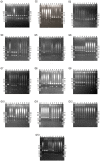Heterogeneity of Helicobacter pylori Strains Isolated from Patients with Gastric Disorders in Guiyang, China
- PMID: 33603417
- PMCID: PMC7886087
- DOI: 10.2147/IDR.S287631
Heterogeneity of Helicobacter pylori Strains Isolated from Patients with Gastric Disorders in Guiyang, China
Abstract
Purpose: Chronic Helicobacter pylori infection causes peptic ulcers in a subpopulation of individuals and is a risk factor for the development of gastric cancer. Multiple infections and heteroresistant H. pylori contribute to poor treatment efficacy. Here, we investigated the extent of genetic diversity among H. pylori strains within a given host and its influence on the results of antibiotic (metronidazole, levofloxacin, clarithromycin, amoxicillin, and tetracycline) susceptibility testing.
Materials and methods: Gastric mucosa biopsy samples were obtained from patients with gastric disorders, including 48 H. pylori positive patients, who were never previously treated for H. pylori infection. Five potential H. pylori colonies isolated from each sample were subcultured for enrichment. Enriched H. pylori colonies were identified through Gram staining and assays for urease, oxidase, and catalase. For each H. pylori monoclonal colony, the antibiotic susceptibility was assessed, genomic DNA was sequenced, and the cytotoxin-associated gene A (cagA) genotype was verified. Co-infection with multiple H. pylori strains was determined using random amplified polymorphic DNA (RAPD)-polymerase chain reaction (PCR).
Results: Thirteen gastric mucosa biopsy samples were positive for H. pylori. Five monoclonal strains isolated from each of these 13 patients were identified as H. pylori. RAPD-PCR indicated that intra-patient monoclonal strains of H. pylori in 10 of the 13 samples exhibited heterogeneity. Among the 13 patients, intra-patient monoclonal strains isolated from 4 patients had identical cagA genotype, whereas intra-patient monoclonal strains isolated from the other 9 patients harbored more than one cagA genotype. The antibiotic susceptibility of five intra-patient monoclonal strains from seven patients was inconsistent.
Conclusion: The existence of heterogeneous H. pylori strains with resistance to different drugs and virulence were common within the gastric mucosa of an individual patient.
Keywords: Helicobacter pylori; antibiotic resistance; cagA typing; heterogeneity.
© 2021 Mi et al.
Conflict of interest statement
The authors declare no conflicts of interest for this work.
Figures

Similar articles
-
Antibiotic resistance and clonal relatedness of Helicobacter pylori strains isolated from stomach biopsy specimens in northeast of Iran.Helicobacter. 2020 Apr;25(2):e12684. doi: 10.1111/hel.12684. Epub 2020 Feb 19. Helicobacter. 2020. PMID: 32074664
-
The analysis of virulence factors and antibiotic resistance between Helicobacter pylori strains isolated from gastric antrum and body.BMC Gastroenterol. 2019 Aug 7;19(1):140. doi: 10.1186/s12876-019-1062-5. BMC Gastroenterol. 2019. PMID: 31390989 Free PMC article.
-
Heterogeneity of cag genotypes in Helicobacter pylori isolates from human biopsy specimens.J Clin Microbiol. 2003 Mar;41(3):976-80. doi: 10.1128/JCM.41.3.976-980.2003. J Clin Microbiol. 2003. PMID: 12624018 Free PMC article.
-
[Detection of Helicobacter pylori and antimicrobial resistance in gastric biopsy specimens].Mikrobiyol Bul. 2012 Jul;46(3):398-409. Mikrobiyol Bul. 2012. PMID: 22951652 Turkish.
-
Genetic Exchange.In: Mobley HLT, Mendz GL, Hazell SL, editors. Helicobacter pylori: Physiology and Genetics. Washington (DC): ASM Press; 2001. Chapter 28. In: Mobley HLT, Mendz GL, Hazell SL, editors. Helicobacter pylori: Physiology and Genetics. Washington (DC): ASM Press; 2001. Chapter 28. PMID: 21290731 Free Books & Documents. Review.
Cited by
-
Association Between Biofilm Formation and Structure and Antibiotic Resistance in H. pylori.Infect Drug Resist. 2024 Jun 20;17:2501-2512. doi: 10.2147/IDR.S468126. eCollection 2024. Infect Drug Resist. 2024. PMID: 38933776 Free PMC article.
-
Helicobacter pylori: an up-to-date overview on the virulence and pathogenesis mechanisms.Braz J Microbiol. 2022 Mar;53(1):33-50. doi: 10.1007/s42770-021-00675-0. Epub 2022 Jan 6. Braz J Microbiol. 2022. PMID: 34988937 Free PMC article. Review.
-
High prevalence of Helicobacter pylori mixed infections identified by multilocus sequence typing in Ningbo, China.Front Microbiol. 2023 Aug 8;14:1207878. doi: 10.3389/fmicb.2023.1207878. eCollection 2023. Front Microbiol. 2023. PMID: 37614601 Free PMC article.
-
One-Pot Microfluidics to Engineer Chitosan Nanoparticles Conjugated with Antimicrobial Peptides Using "Photoclick" Chemistry: Validation Using the Gastric Bacterium Helicobacter pylori.ACS Appl Mater Interfaces. 2024 Mar 27;16(12):14533-14547. doi: 10.1021/acsami.3c18772. Epub 2024 Mar 14. ACS Appl Mater Interfaces. 2024. PMID: 38482690 Free PMC article.
-
Effective Eradication Regimen and Duration According to the Clarithromycin Susceptibility of Helicobacter pylori Determined Using Dual Priming Oligonucleotide-Based Multiplex Polymerase Chain Reaction.Gut Liver. 2023 Sep 15;17(5):722-730. doi: 10.5009/gnl220256. Epub 2022 Sep 28. Gut Liver. 2023. PMID: 36168964 Free PMC article.
References
-
- Correa P. Helicobacter pylori as a pathogen and carcinogen. J Physiol Pharmacol. 1997;48(5):19–24. - PubMed
LinkOut - more resources
Full Text Sources
Other Literature Sources

